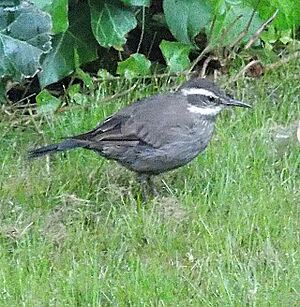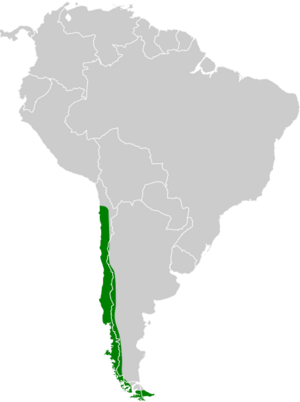Grey-flanked cinclodes facts for kids
Quick facts for kids Grey-flanked cinclodes |
|
|---|---|
 |
|
| Conservation status | |
| Scientific classification | |
| Genus: |
Cinclodes
|
| Species: |
oustaleti
|
 |
|
The grey-flanked cinclodes (Cinclodes oustaleti) is a small bird. It belongs to the ovenbird family, called Furnariidae. You can find this bird in Argentina and Chile. It used to be known as Oustalet's cinclodes.
Contents
About the Grey-flanked Cinclodes
Bird Family and Types
The grey-flanked cinclodes is part of a group of birds called cinclodes. It is very similar to Olrog's cinclodes. There are three different types, or subspecies, of the grey-flanked cinclodes:
- C. o. oustaleti
- C. o. hornensis
- C. o. baeckstroemii
What Does This Bird Look Like?
The grey-flanked cinclodes is about 17 to 18 centimeters (6.7 to 7.1 inches) long. It weighs between 22 and 31 grams (0.78 to 1.1 ounces). Both male and female birds look the same.
This bird has a medium-sized bill that curves slightly downwards. It has a light, creamy stripe above its eye. Its face near the eye is dark brown. The area below its eye is whitish with dark marks.
The top of its head is dark grayish brown. Its back and wings are a rich dark brown. The outer tail feathers have dull reddish-brown tips. Its throat is white. The chest is dull dark gray-brown with pale spots. The belly is lighter and brownish. Its sides and under its tail are dark brown. Its eyes are dark, and its bill, legs, and feet are blackish.
Differences in Subspecies
- The C. o. hornensis subspecies is not as richly colored. It has darker gray on its upper parts. Its underparts are grayer, not as brown.
- The C. o. baeckstroemii subspecies looks like the main type. But it has a reddish tint on its sides and under its tail.
Where the Grey-flanked Cinclodes Lives
Bird's Home Range
The main type of grey-flanked cinclodes lives in South America. You can find it in Chile (from the Antofagasta Region) and western Argentina (from Mendoza Province). It lives south to the Strait of Magellan in both countries.
- The C. o. hornensis subspecies lives on Chile's Desolación Island. It also lives on Tierra del Fuego (in Chile and Argentina) and the Cape Horn Archipelago.
- The C. o. baeckstroemii subspecies is only found on Alejandro Selkirk Island. This island is part of Chile's Juan Fernández Islands.
Preferred Habitat
This bird likes open areas with grass and rocks. In mountains, you often see it near streams. It can live from sea level up to 4,200 meters (13,800 feet) high.
How the Grey-flanked Cinclodes Behaves
Movement and Migration
Most grey-flanked cinclodes stay in the same area all year. However, some may move to lower places in winter. The C. o. hornensis subspecies is partly migratory. Some of these birds fly north to the mainland after they breed.
What the Bird Eats
The grey-flanked cinclodes eats arthropods, which are like insects and spiders. It probably eats other small creatures too. It looks for food alone or in pairs. It picks up its prey from the ground, mud, and rocks.
Reproduction and Life Cycle
The grey-flanked cinclodes breeds in the spring and summer. This includes at least the month of October. It is thought that one male and one female bird stay together to raise their young.
They build their nest in a burrow. The bird digs a tunnel in an earth bank, often near a stream. The nest chamber is lined with plant fibers and hair. A female usually lays two eggs. We do not know how long the eggs take to hatch. We also do not know how long it takes for the young birds to leave the nest.
Bird Sounds
The song of the grey-flanked cinclodes is a fast, dry, twittering trill. It starts with a few single notes and then gets higher in pitch. Its call is a dry "tsick."
Conservation Status
The IUCN (International Union for Conservation of Nature) has listed the grey-flanked cinclodes as a species of Least Concern. This means it is not currently in danger of disappearing. It lives across a large area. However, we do not know how many of these birds there are. Their numbers are thought to be going down. No immediate dangers have been found for this bird. It is seen as uncommon to fairly common. Its home is not much disturbed by humans, except for some grazing animals.


